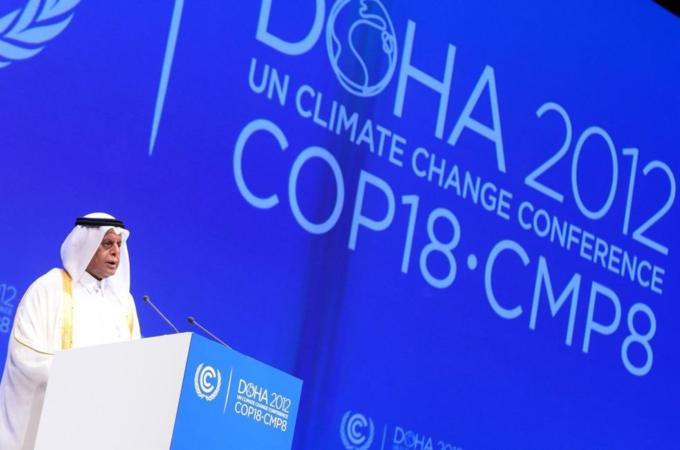The 18th United Nations climate change conference has opened in Doha, the Qatari capital.
Over the next two weeks, up to 17,000 people will attend the conference. Delegates will be negotiating a new global deal on climate, but there are ongoing tensions between rich and poor countries.
The meeting elected the former Qatari energy minister Abdullah bin Hamad al-Attiyah, as president of the Conference of the Parties.
“This is an historic conference,” said Attiyah, “it is of vital importance considering the items on its agenda. It is a turning point in the negotiations on climate change.”
Maite Nkoana-Mashabane, South African foreign minister, officially handed over the COP presidency to Attiyah, Qatar’s deputy prime minister, at the Qatar National Convention Centre in Doha.
After brief speeches by both, Christiana Figueres, UNFCCC executive secretary, pointed out the “unique” location of this year’s COP.
“Each COP is unique – and this is no exception,” she said.
“This is the first time the COP is being held in the Gulf region. On this historic occasion, the region has an unequaled world stage to showcase the contributions being made to reduce the Gulf’s food and water vulnerabilities, to put regional energy growth on a more sustainable path and to build a safer, stronger and more resilient energy future for all countries.”
Carbon permits
A central issue at the summit is the problem of “hot air” carbon permits.
The term refers to attempts by some wealthy countries to carry over unused carbon permits so they can be offset against future cuts.
Developing nations say this is unfair and reduces the value of any commitment to reduce carbon dioxide.
In one of the summit’s first announcements, Australia said it will aim to cut its emissions by 0.5 per cent from 1990 levels by 2020 in a second commitment period of the Kyoto Protocol.
Maxwell Smith of the Australian Youth Climate Coalition told Al Jazeera he thought Australia’s decision to participate in a second period of the Kyoto Protocol was a “positive step”. But, he added, a 0.5 per cent reduction was “nothing. That is completely unacceptable”.
At the opening session of a working group on the Kyoto Protocol on Monday afternoon, New Zealand said that, although it would not join the second commitment period, it would continue to “play by the Kyoto rules” and work to combat climate change.
New Zealand noted that, under a second commitment period, the countries that would be required to make emissions cuts only make up about 15 per cent of worldwide emissions.
A Nauru delegate, speaking on behalf of the Alliance of Small Island States – a group representing 44 mostly low-lying countries particularly vulnerable to climate change – called for greater ambition for a second commitment period of the Kyoto Protocol, which binds many developed countries to make emissions cuts.
“This conference is about nothing less than preserving the fundamental integrity of the climate change regime,” she said, “and that must begin with a strong second commitment period under the Kyoto Protocol.
“If developed countries cannot live up to their current obligations, how can we have any confidence in a future agreement?”
Nauru also called for stronger commitments from developed countries to help developing countries finance ways to reduce their greenhouse gas emissions.
Currently, developed countries have pledged to provide $100bn a year for adaptation and mitigation measures for developing countries by 2020.
As Qatar welcomes world leaders to the conference, its own environmental record has come under criticism as a major contributor to greenhouse gases.
Spotlight on polluters
The climate talks have placed a spotlight on Qatar, which produces nearly 50 tonnes a year of carbon dioxide for each of its 1.6 million residents.
“We are fully aware of the perils the world is facing as a result of climate change,” Attiyah, who is also a former Qatari petroleum minister, said.
“We hope the conference will produce tangible results and reinforce international co-operation.”
Qatar “is also one of the 10 developing countries predicted to be most affected by rising sea levels”, Attiyah said.
“Environmental sustainability is a key pillar of our national vision,” he said.
In terms of volume, China remains the top emitter with more than eight billion tonnes of greenhouse gases every year – an increase of 171 per cent since 2000.
China is followed by the US, which produces over five billion tonnes annually, although its emissions have fallen since 2007.
In third place is India. Its economic boom has made it the third worst polluter, pumping out nearly two billion tonnes of carbon dioxide a year.
And then there is Russia, producing around 1.6bn tonnes of emissions every year.



